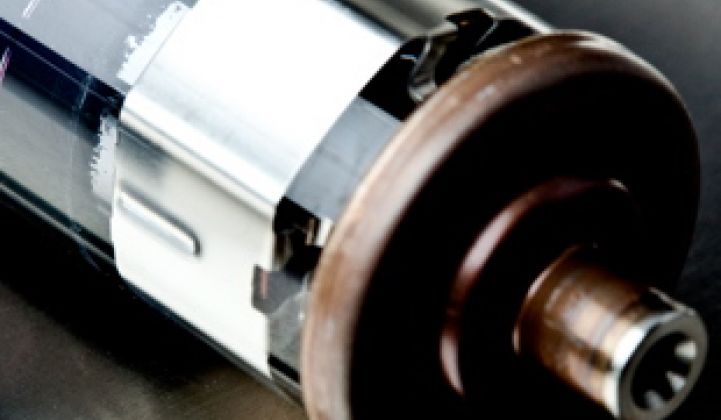This week saw a number of funding incidents in solar. Here's a quick round-up.
1366 Technologies Wins $150 Million Loan Guarantee
Massachusetts' 1366 Technologies just announced that the U.S. DOE has offered a conditional commitment to the startup for a $150 million loan guarantee. The company is working on a method of fabricating silicon solar cells directly from molten silicon, and process that will be cheaper and require less material. This contrasts with the multi-step, batch process of ingot casting, blocking, squaring, and sawing that wastes significant portions of high-value silicon.
The DOE and Steve Chu have been absolutely ebullient about this firm for years, despite its lack of commercial progress so far. In October 2009, 1366 received a $4 million grant from the DOE’s Advanced Research Projects Agency (ARPA-E) to support the development of this technology. This processing technology fits into Chu's SunShot program vision of $0.50-per-watt modules.
The loan will play a role in the company’s expansion, creating two facilities and new jobs. The first 20-megawatt commercial facility, to be sited in Massachusetts, is scheduled to be operational by 2013. Construction of a larger 1,000-megawatt facility is hoped to commence in 2013 and create 300 permanent positions.
To date,1366 Technologies has raised $46 million from equity investors including GE Energy Financial Services, VantagePoint Venture Partners, Hanwha Chemical, and others.
1366 fits into the "thin silicon" sector and the startup has lots of company in that space, including AstroWatt, SiGen, Ampulse, Crystal Solar, Bandgap Engineering, and possibly Twin Creeks.
We've looked at the pros and cons of loan guarantees here. Note that Suniva chose to suspend the pursuit of their loan guarantee. And Solar Junction (triple-junction solar cells for CPV) is still hoping to hear the status of their loan guarantee, which is currently in the due diligence period.
Within the last month we've seen loan guarantees in solar for Cogentrix's CPV efforts with Amonix, $2 billion for two CSP projects (Abengoa and NextEra), FRV's 20-megawatt PV power plant, CaliSolar ($275 million for UMG) and Sempra ($360 million for a PV power plant).
Siemens Acquires Stake in U.S.-Based CPV Solar Startup Semprius
Siemens just acquired about 16 percent of Durham, North Carolina-based Semprius, a startup focused on building high concentrating photovoltaic (HCPV) modules.
Semprius' HCPV modules use high-performance lenses to focus the sun's light onto very small, highly efficient (>40 percent NREL Certified) cells.
Spun out of the University of Illinois and founded in 2005, Semprius raised a $4.7 million round A in 2007, and, more recently, won an additional $7.9 million from Applied Ventures, ARCH Venture Partners, GVC Investment Fund, Intersouth Partners, In-Q-Tel, Illinois Ventures and X-FAB Semiconductor Foundries.
The 30-employee firm aspires to be a vertically integrated manufacturer of HCPV panels using their own gallium arsenide (GaAs) micro transfer printing-based chips while selling the panels to system integrators for mounting on 2-axis trackers.
Semprius does its own cell design and outsources the epi process. Their micro-transfer printing technology allows the firm to reuse the GaAs substrate rather than shipping the expensive substrate out the door with every cell. Semprius claims that by reusing the substrate, they can reduce the cost by fifty percent. The cell structure is grown on top of a release layer so that the cells can be epitaxially lifted off as part of the micro-transfer printing process.
The Semprius GaAs double-junction cells measure 600 microns by 600 microns. This is 300 times smaller than the standard industry cells, which in turn results in fewer defects, better quality, and the use of less current and therefore less heat through the cell, according to Bob Conner, the VP of Photovoltaics at Semprius. Smaller chips also mean smaller optical elements and simpler optics, as well as a smaller module size. Less heat means that Semprius can dispense with the heat sinks and heat spreaders used by the majority of CPV players. Conner hails CPV as having the highest conversion efficiency, lowest temperature degradation and the highest capacity factor of all solar power technologies.
Google Deploys $280 Million for SolarCity's Residential Solar Financing
SolarCity and Google (NASDAQ: GOOG) announced the birth of a $280 million fund to finance residential solar projects. The fund is SolarCity’s largest project financing fund and the largest residential solar fund created in the U.S. SolarCity has built 15 project funds with seven different partners to finance more than $1.25 billion in solar projects.
Solyndra Gets $10.3M in VC, Plus Help From Ex-Im Bank and No Help From National Review
Solyndra of Fremont, California, the beleaguered cylindrical CIGS solar manufacturer, is using project financing from the U.S. Export-Import Bank to facilitate the sale of its solar panels to a private-sector project in Belgium. Ex-Im Bank is guaranteeing a $10.3 million loan provided by KBC Bank in Belgium to finance the sale of Solyndra's solar panels for a three-megawatt rooftop PV project. This is the company's first transaction with Ex-Im Bank and its largest rooftop solar project globally to date.
Katie Fehrenbacher of Earth2Tech, in her SEC Form D investigations, discovered that Solyndra has received $10.6 million more in equity funding in “a private transaction with an existing investor in anticipation of future growth.”
And despite the DOE loan guarantee process being rigorous and thorough, Solyndra continues to catch flak from the right wing for some type of shenanigans in the loan guarantee process. Here's NRO taking unsubstantiated potshots.



